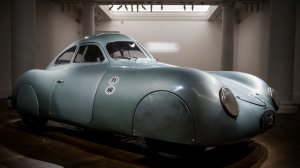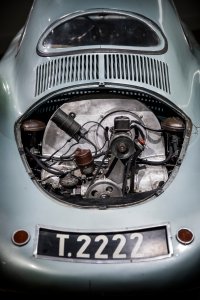A bulbous race car from the 1930s was expected to be the most expensive car with the Porsche name ever sold at auction. But the sale was marred by a confusing mix-up on the auction stage.
Technically speaking, the Type 64 isn’t really a Porsche because the company didn’t yet exist when Ferdinand Porsche created the car in Nazi Germany. But its role as the ancestor of today’s Porsche sports cars is clear, and it was expected to sell Saturday for as much as $20 million.

But the California auction, with bidding that went as high as $17 million, ended with the car remaining unsold. Auction sellers often have an undisclosed minimum price below which the car will not be sold. That figure, called the reserve price, was not reached.
The trouble started at the RM Sotheby’s Monterey auction as soon as bidding on the Type 64 started.
In videos posted online of the event, the auctioneer called out an opening bid of $13 million but the large screen behind, which which showed the current bid price, showed $30 million.
Many in the audience gasped and others laughed. It was unclear from the auctioneer’s voice that he was, in fact, saying “-teen” and not “-ty.” The problem continued right through $14 million, which was displayed as $40 million then $15 million was shown on the screen as $50 million. The board read $70 million before the auctioneer realized the trouble just behind him and asked for it to be corrected.

Some in the audience booed as the price was corrected. After that, the bids stopped coming and the sale was hammered to a close at $17 million dollars.
It was an honest mistake, RM Sotheby’s said in a statement, and it wasn’t staged. “We take pride in conducting our world-class auctions with integrity and we take our responsibility to our clients very seriously. This was in no way a joke or stunt on behalf of anyone at RM Sotheby’s, rather an unfortunate misunderstanding amplified by excitement in the room.”
If the car had been allowed to sell for $17 million, that would have been the highest price ever paid for a car with the Porsche name. Had it sold for $70 million, the price mistakenly shown on the screen, it would have been the most valuable car of any kind ever sold at auction by a wide margin.
The Type 64 looks a little like a child’s clay model of a modern Porsche. It was Ferdinand Porsche’s early attempt at designing a sports car with the engine in the back. This was the same basic idea the Porsche car company would use in its first car, the 356, and later in the 911.
“If you put anybody with passing knowledge of automobiles in front of that car and asked them what it was, they would probably say ‘Porsche,’ because it’s really pretty obvious,” Leslie Kendall, curator at the Petersen Automotive Museum in Los Angeles, said in the weeks leading up to the auction.
The Type 64 was based on one of Ferdinand Porsche’s earlier designs, the KdF-Wagen. The Kraft-durch-Freude-Wagen (which translates to “strength through joy car”) was supposed to be an inexpensive automobile for German families, something the Nazi government could celebrate as an achievement for its people. It never went into large scale production during the Nazi era but, after the war, it would become known as the Volkswagen Beetle.
Porsche saw the potential for a racing car based on the KdF-Wagen’s rear-engined design. Having the engine in the back put weight over the wheels that propelled the car, helping with traction when on slippery roads and while accelerating. In the hands of a skilled driver, a rear-engined car could also take tight turns without the weight of an engine up front pulling the car’s nose outwards. Of course, it did tend to pull the tail outwards and could make the car spin around, one of the inherent hazards of this type of design.
The first Type 64 was built to compete in a Berlin to Rome road race scheduled for September 1939. Its chassis and engine were borrowed from the KdF-Wagen, but the engine was altered slightly, boosting its output to 32 horsepower. That was a respectable figure for a car of its size and weight at the time. Aircraft construction technologies were used to make the lightweight alloy body.
On September 1, 1939, German armed forces invaded Poland, sparking World War II. The Berlin-Rome race never happened. The factories that were to have built KdF-Wagens for German families were given over to producing Porsche-designed military vehicles instead. Only one Type 64 had been built by this time, but a second was completed later.
The one sold in Monterey was, technically, the third car, but it was built on the frame of the first after it had been crashed by a Nazi-era Volkswagen executive. The second Type 64 was confiscated by Allied forces after the war and crashed soon after. It was later rebuilt and is now on exhibit at a museum in Hamburg, Germany, after spending some time at the Petersen Museum.
The Porsche family was allowed to keep this particular Type 64 and it was driven extensively by both Ferdinand and his son Ferry, who would later create the 356. Ferry applied the family name to the front of the car. In 1947, this Type 64 was restored by the Turin, Italy, auto design and manufacturing firm known today as Pininfarina.
RM Sotheby’s said Sunday that it is continuing to try to close a sale on the car.




















